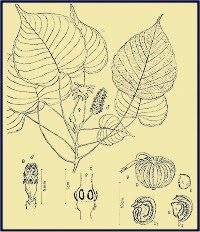Hura
crepitan
Synonyms
Hura
brasiliensis L.
Common names
Sandbox tree, possumwood, monkey's dinner bell,
monkey's pistol
Origin
Native to the tropical regions of North and South
America in the Amazon Rainforest.
Ecology
Dispersal: Capsule explodes to disperse seed up to 14
metres away. Introduced by humans to Africa as a shade plant.
Reproduction: Fruits are capsules, 3 to 5 cm in length
with a diameter of 5 to 8 cm. 16 carpels are arranged radially around the
central axis. Seeds are flattened and 15 to 25 mm in diameter.
Herbivores: No information available.
Resistant stages: No information available.
Habitat
In its introduced range, Hura crepitans occurs in
forest edges and gaps.
Description
Hura crepitans is a tree growing to 40 meters high. It
can be distinguished by its many dark, pointed (conical) spines. Its common
name 'Monkey-no-
climb is in reference to the characteristic spiny trunk.
The leaves are papery thin, heart-shaped and up to 60
cm long.
The berry look-alike structure is actually the male
flowers that have no petals. Male flowers grow on long spikes; female flowers
are solitary. Male flowers are ovoid to conical (5 by 2 cm), mostly dark red in
colour. Flower stalks (pedicels) up to 10 cm long; female flowers without
pedicel; fruiting pedicel pendant to 6 cm; fruit oblate (3-5 x 8-9 cm) in
diameter, reddish brown on colour, concave at the tip and
base, longitudinally
grooved.
Fruits are pumpkin-shaped capsules, 3-5 cm in length
with a diameter of 5-8 cm; it has 16 carpels arranged radially around the
central axis. Seeds are flattened and about 2 cm in diameter.
Reproduction and dispersal
The fruit of Hura crepitans opens with an explosive
sound into segments, hence the name 'dynamite tree'. Seeds are dispersed up to
14
metres away.
Economic and other uses
Hura crepitans is cultivated for medicinal and
ornamental purposes. The latex is used
as arrow poison and is said to cause ailing teeth to fall out. As medicine, it
treats skin diseases, rheumatism, intestinal worms and has been used in the
United States of America to prepare tear gas; bark extract is used to treat
leprosy and wood used in light construction.
Environmental and other impacts
The large leaves of Hura crepitans enable the plants
to grow in deep shade, allowing the plant to establish in undisturbed forest
outcompete indigenous vegetation. H. crepitans is among the 14 commoner causes
of plant contact dermatitis in the Dominican Republic. Tree fellers have to
cover their eye since the sap causes temporary blindness. The segments of the
woody fruits can cause dermatitis when they are used in bracelets and
necklaces.
Management
The precise management measures adopted for any plant
invasion will depend upon factors such as the terrain, the cost and
availability of labour, the severity of the infestation and the presence of
other invasive species.
The best form of invasive species management is
prevention. If prevention is no longer possible, it is best to treat the weed
infestations when they are small to prevent them from establishing (early
detection and rapid response). Controlling the weed before it seeds will reduce
future problems. Control is generally best applied to the least infested areas
before dense infestations are tackled. Consistent follow-up work is required
for sustainable management.







No comments:
Post a Comment